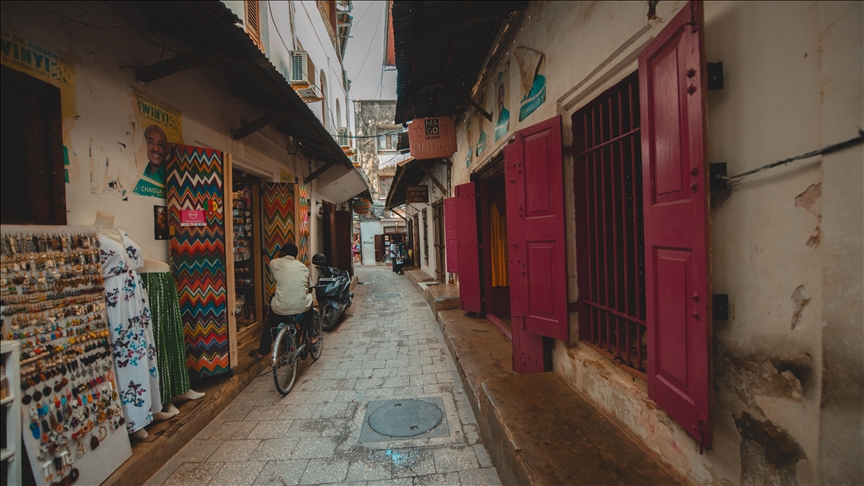Stone Town: Zanzibar heritage site shaped by the sea fights to survive its rise
The same ocean that once brought prosperity to Stone Town now poses an existential threat, as rising sea levels and extreme weather steadily erode its foundations
 A general view from Stone Town, Zanzibar, Tanzania on December 25, 2024.
A general view from Stone Town, Zanzibar, Tanzania on December 25, 2024.
- ‘I’ve seen the ocean creep closer every year. When I was a boy, the beach was much wider, but now the water reaches our doorsteps,’ says Ali Seif Hamad, a lifelong resident of Stone Town
- ‘Slavery, colonization, revolution – we’ve survived it all. We’ll survive this too,’ says Ali Said Bakar, director of the Stone Town Preservation and Development Authority
UNGUJA, Tanzania
Under the warm glow of paraffin lanterns at Forodhani Park, a lively culinary hotspot in Zanzibar’s historic Stone Town, the clinking of spoons against plates blended with the salty breeze from the Indian Ocean.
Salma Mansour Ahmed, draped in a flowing black burqa, laughed softly as she savored a bowl of Zanzibar mix, a popular street food also known as ‘Mbatata urojo.’
“This is what I love about Stone Town,” she said, glancing around at the vibrant evening scene. “Tasty food, the history, the sea. It’s all here.”
Around her, tourists meandered through the labyrinthine streets, browsing for souvenirs, while stray cats prowled the alleys, their urgent meows rising as they scavenged for scraps.
The charm of Stone Town was alive, its rich history and cultural blend present in every street corner.
But as Ahmed’s gaze shifted toward the waves crashing against the concrete embankment, her tone darkened.
“The sea,” she said, her voice dropping, “is also taking it all away.”

A city shaped by the sea, now threatened by it
For centuries, Stone Town has stood as a testament to Zanzibar’s diverse cultural heritage. Its narrow alleys, elaborately carved wooden doors, and coral-stone buildings reflect a confluence of Arab, Persian, Indian, and African influences.
Once a thriving hub of trade and commerce, the town was designated a UNESCO World Heritage site in 2000 for its historical significance.
But the same ocean that once brought prosperity to Stone Town now poses an existential threat.
Rising sea levels, coupled with increasingly violent storms, are steadily eroding the town’s foundations. The saltwater seeps into the coral-stone walls, weakening them from within and hastening their collapse.
“This is a very serious problem, but we are taking action to mitigate the effects of rising sea levels,” said Ali Said Bakar, director of the Stone Town Preservation and Development Authority.
Bakar and his team are racing against time to safeguard the town’s historic buildings, implementing a combination of modern engineering solutions and traditional construction techniques to protect against the encroaching tides.
He has dedicated years to protecting Stone Town’s architectural legacy, and leads a team of architects, engineers, and volunteers overseeing the restoration of some of the town’s most endangered structures.
“The coastline is rapidly shrinking, but engineers are tirelessly working to erect stronger barriers,” he told Anadolu.
Efforts to protect the town include reinforcing the sea walls, restoring aging buildings, and engaging the local community in mangrove restoration – an ecological strategy that helps absorb the impact of waves.
“We combine traditional knowledge with modern engineering to preserve what we can,” he explained.

Human costs and stories of survival
Yet despite these efforts, the forces of nature continue to threaten Zanzibar’s historic core.
For Ali Seif Hamad, a seasoned tour guide and lifelong resident of Stone Town, the changes have been personal.
“I’ve seen the ocean creep closer every year,” he said. “When I was a boy, the beach was much wider, but now the water reaches our doorsteps.”
Hamad’s guided tours often conclude at the House of Wonders, a grand 19th-century palace that once symbolized Zanzibar’s wealth and influence. Now, the building lies in ruins, its facade supported by scaffolding after years of neglect and saltwater damage.
“This place used to draw so many tourists,” Hamad lamented. “Now, it’s just another crumbling relic.”
The impact of climate change on Stone Town extends beyond its crumbling architecture. The rising tides have taken a toll on its people, particularly those who rely on fishing and tourism – two industries crucial to Zanzibar’s economy.
Salma Ahmed Hirji, a local conservationist, has been working with women’s groups to raise awareness about climate change and its devastating impact on their community.
“Climate change is not just affecting the environment,” she explained. “It affects our culture, our livelihoods, and our identity.”
Fisherfolk, who once depended on stable weather patterns, now face unpredictable storms that make their work increasingly dangerous. Tour operators, whose businesses rely on the town’s historical appeal, worry that if the structures continue to decay, tourism revenue will dwindle.
“The weather is not predictable at all,” Hirji said. “That uncertainty affects everything.”

What lies ahead?
Recognizing the urgency of the situation, international organizations have stepped in to help. UNESCO, in partnership with local authorities, has launched restoration projects aimed at preserving Stone Town’s unique architecture.
The initiative not only focuses on repairing buildings but also trains local artisans in traditional construction methods, ensuring that the craftsmanship of past generations is not lost.
“We’re not just restoring buildings,” Bakar emphasized. “We’re restoring a way of life.”
Beyond physical preservation, efforts are also being made to document Stone Town’s intangible cultural heritage – its music, cuisine, and oral traditions – so that even if the landscape changes, the town’s legacy endures.
Despite the daunting challenges, there is a shared sense of resilience among Stone Town’s residents. At Forodhani Gardens, as the evening progressed, more locals gathered, enjoying the cool breeze and each other’s company.
Fatma Karim Juma, a longtime resident, recalled how her family had to rebuild their home after it was damaged by flooding.
“It was hard,” she admitted, “but we didn’t give up. This town is our home, and we will do whatever it takes to protect it.”
That determination is echoed by preservationists like Bakar, who remains steadfast in his mission.
“Stone Town has faced many challenges in its history,” he said. “Slavery, colonization, revolution – we’ve survived it all. We’ll survive this too.”
Preserving Stone Town is an enormous task, requiring both immediate interventions and long-term strategies.
Bakar and his team continue to push for more resources, funding, and awareness to ensure that the town’s historical legacy is not lost to the rising tides.
“We will do everything possible to restore buildings and preserve a legacy for future generations,” he affirmed.
As the tide crept higher along the shore, Ahmed stood with her friends, their laughter interwoven with the sound of crashing waves.
“We can’t let the sea take this away from us,” she said.








